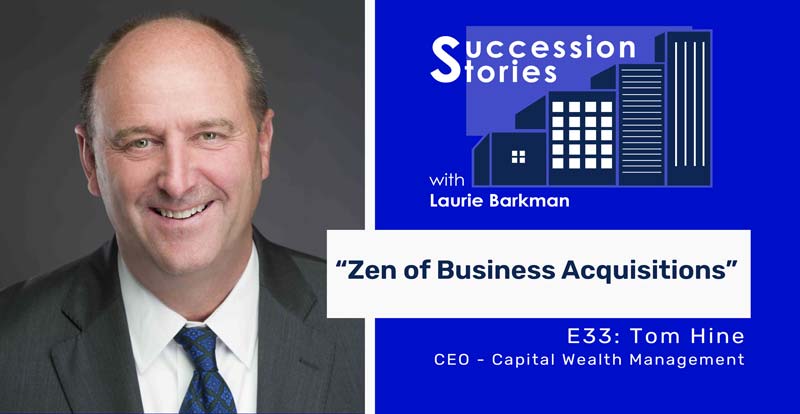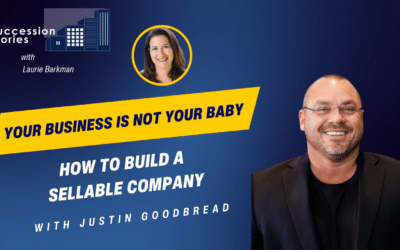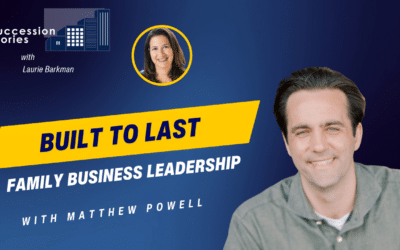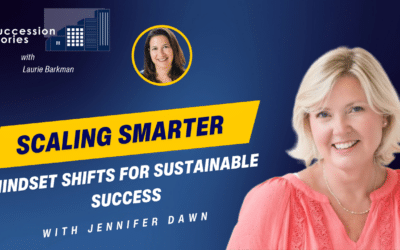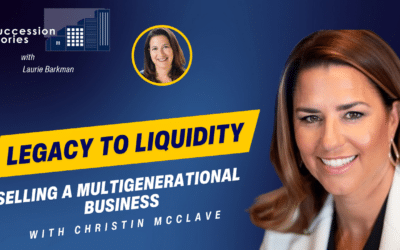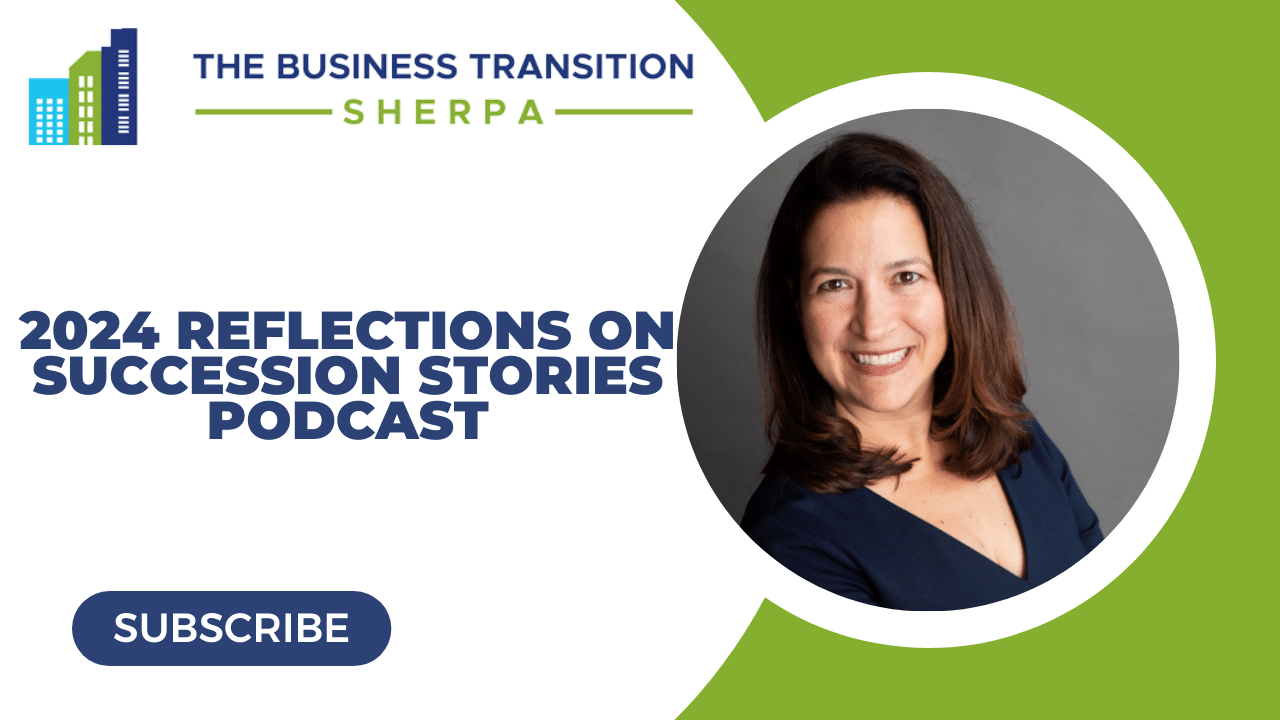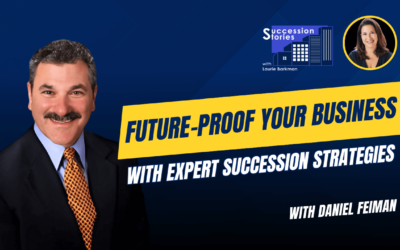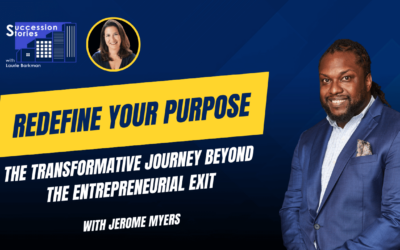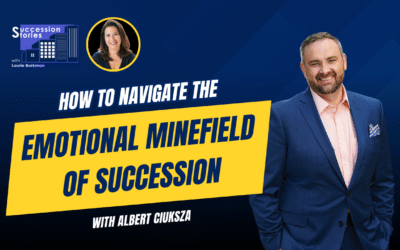Listen to the episode:
Laurie Barkman talks about navigating business acquisitions and succession planning with Tom Hine, CEO of Capital Wealth Management, and author of, The Zen of Business Acquisitions. Tom has acquired seven wealth management firms and conducted due diligence on more than 100 others. Tom draws from his black belt experience in M&A and karate. To increase your odds of success, you have to work at being prepared.
Listen in to learn more about:
- The Beginner’s Mindset
- What buyers look for in an acquisition
- Why company cultures need to mesh instead of match
- How the best deals are the bad ones you never do
- Difference between continuity and succession planning
- Planning your transition successfully
Show Links
Capital Wealth Management website
The Zen of Business Acquisitions on Amazon
Succession Stories E29 Letting Go
Connect with the host, Laurie Barkman on SmallDotBig.com and sign-up for an insights newsletter to build value in your company.
Subscribe to the podcast
Subscribe wherever you listen, Apple Podcasts, Google Podcasts, Spotify, YouTube, and more.
If you enjoy the episode, please give a 5-star rating and review to help others find the content. Here’s a quick how-to review on Apple Podcasts/iTunes from your desktop.
Transcript:
Laurie Barkman:
Welcome to Succession Stories, insights for next generation entrepreneurs. I’m Laurie Barkman. I’ve spent my career bringing an entrepreneurial approach to mature companies struggling with change as an outside executive of a third generation, 120 year old company, I was part of a long-term succession plan.
Now I work with entrepreneurs, privately held companies, and family businesses to develop innovations that create enterprise value and transition plans to achieve their long-term goals. On this podcast, listen in as I talk with entrepreneurs who are driving innovation and culture change. I speak with owners who successfully transitioned their company and others who experienced disappointment along the way.
Guests also include experts in multi-generational businesses and entrepreneurship. If you are a next generation entrepreneur looking for inspiration to grow and thrive, or an owner who can’t figure out the best way to transition their closely held company, this podcast is for you.
Subscribe to our newsletter for more resources to build value in your business and plan your transition. Visit SmallDotBig.com and sign up today.
Laurie Barkman:
Tom Hine is the CEO and Principal of Capital Wealth Management. He’s an author, CERTIFIED FINANCIAL PLANNER™, and 25-year veteran of the financial services industry. He has acquired seven wealth management firms and conducted due diligence on more than 100 others. He’s also a 4th degree black belt in karate. In Tom’s latest book, The Zen of Business Acquisitions, his goal is to help other small business owners succeed in retirement planning, succession planning, and future mindfulness. A key theme is that M&A comes in all flavors and styles. Whether you’re a buyer or a seller, to increase your odds of success, you have to work at being prepared.
Laurie Barkman:
Tom, welcome to the show. I’m really excited for our conversation today. You’re the CEO and principal of Capital Wealth Management in Connecticut with more than 25 years in the financial services industry.
I’m excited to talk to you about your book, your experience buying financial services practices, and this view you have through the lens of martial arts strategies. Your book is called The Zen of Business Acquisitions. How did you come up with the idea for the book?
Tom Hine:
Well, thanks for having me, Laurie. It’s a pleasure to be here. The genesis of the book was that I’ve been practicing martial arts my whole life. I wanted to come up with something positive about the acquisitions business to write about but everybody I’d interviewed said, “Oh, that book’s already been done.”
So after about five different discussions with people, I said, “Okay, well, I want to try something different.” I want to write something that’s fun. It has stories, it’s instructive. But what would make it different would be to have some of the martial arts philosophy weaved in there throughout. It’s not a heavy dose of it but it’s enough that people realize the idea of working hard, not giving up and things like that, that we’ve all grown up with. So that theme was what made it seem fun.
When I had my first chapter, I ran it by some people I know very well, who said, I think I got something here like this, this theme could work. So I had good feedback and in the end, it was a joy to write.
Laurie Barkman:
It’s also very timely. I’ve been watching this throwback to the 80s, The “Karate Kid” movies, and now “Cobra Kai,” I don’t know if you’ve seen it. It’s so very timely. I know it goes deeper than that, but I wanted to make that reference. So 30 years of martial arts; it’s a very specific practice, very precise. Yet, acquisitions can be kind of messy. So it’d be fun to talk about some of the things that you’ve learned along the way. And the Zen theme I want to hone in on that.
Before we do though, I know this year has been a very different year for M&A activity. It started out hot, slowed down through the summer. Now we’re seeing M&A activity picking up here at this time of recording, which is the back part of 2020. And we’re expecting to see an uptick with sellers spurring into action. Or they may be more motivated because they want to do a transaction while growth can be shown in their business, and others because they don’t want to wait for another multi-year market cycle and PE firms still have all this dry powder. What trends are you seeing?
Tom Hine:
We’ll take one step back on the Zen aspect, we’ll talk about beginner’s mind. It’s a very important part and the true purpose of Zen. I’ll cover those topics, but the trends that I’m seeing now, and I’m going to break up the industry, for our listeners, there’s three tranches, Laurie, that are important. There’s $1 billion dollars and up in AUM, those are the 800 pound gorillas, I interviewed several of them for my book. Then there’s $1 billion dollars down about $500 million in assets under management, and the smallest tribes that I’m in is below the $500 million of AUM. Although if my next two acquisitions work out well, I’ll be knocking on the door of about $500 million of AUM.
So when I answer questions for you, or any of the listeners, I try to answer it in terms of a specific tranche, because what’s happening at the high end, for example, at the large end above $1 billion, is a lot of M&A activity, a lot of private equity money. People are generally acquiring practices, if you will, or businesses not just for the assets under management, the AUM, but for the actual intellectual property, what they call the IP. So when they buy a firm, the firm may have a specialty and let’s say it’s 401K’s, or asset allocation, or third party asset managers. Whatever that specialty is, a lot of the larger firms will acquire that firm knowing they get the intellectual property along with the assets.
When you’re from $500 million to $1 billion of AUM, that middle tier, they’re the ones most at risk in this fee compression world. Because what’s happening is they’re being threatened by their peers above, people above $1 billion and if they don’t innovate with technology, then they’re just going to become a commodity. That’s a very big danger. Fortunately, firms below $500 million, which is where I spend most of my universe, many of those firms are what they call silos, solo practitioners, and yet, they’re all approaching their 60s or 70s, and some of them are in their 80s. They have to make a decision – even before COVID – what do they want to do with their life’s work and of course, COVID has accelerated that trend. So we’re seeing activity at all three levels, but for different reasons.
Laurie Barkman:
So it’d be interesting as we talk today, if we can make parallels to other industries. I know your specialty is in financial services and that metric you shared of AUM is specific to asset management. If there is a way to generalize it for the audience, that would be good.
We have listeners from a lot of different industries, if you can, that’d be great. If not, that’s okay, too, because I know in the interviews that you’ve conducted for your book, they were primarily financial services. But there were also some software companies and some others, correct?
Tom Hine:
Correct. There are. I will, absolutely, and I interviewed several people in my book that were not related to financial services. I specifically did that, Laurie, so that I could see if my worldview was applicable to other industries and sure enough, it was. So we’ll absolutely touch upon any of those that we need to.
Laurie Barkman:
Great. I have a strange habit of reading magazines back to front. I don’t know why I’ve always done that, and I sometimes do that with books. So I picked up your book and of course, that’s what I did. It was funny, because I just landed on the perfect chapter for people who are short on time. The chapter was called “How to Hack This Book.” Brilliant, just so brilliant. So we’re going to start backwards and work our way forward. A quote that struck me was your summary of lessons learned. You said, When you are content to be simply yourself, and don’t compare or compete, everybody will respect you.” And that was a quote from Lao Tzu. So why did you include that quote?
Tom Hine:
Well, thank you so much. That was my favorite chapter. And I will say – I give the publisher, Georgetown University New Degree Press, all the credit for that – they said, people are so pressed for time they want to get to the meat of the book, what’s in it. So why that quote resonated with me is, across many different industries, whether you’re a plumber, electrician, or one of my local guys that runs a carwash in town – I interviewed Mike in the book – everybody had this sort of mania. One of my chapters is on acquisition mania.
Everyone thinks you have to acquire and merge to get bigger. Certainly, if that’s your goal in life, and if you’re good at it, I say all the power to you. But I also felt that people were being pressured to do deals and sometimes jump into a bigger swimming pool, they weren’t ready for. And so this idea of being content, if someone has $500 million of assets, that’s a good size firm, and they shouldn’t feel inadequate, that they’re not at a $1 billion dollars. If someone has $250 million of AUM, that’s a really big achievement. They might think, well, I don’t manage $10 billion.
I wanted to give people a sense that wherever you are, this book can take you to the next level. But don’t be dissatisfied where you are. Because to survive in this business, or any business for five or 10 years, you should recognize that as a success story in and of itself.
Laurie Barkman:
That’s great. I want to talk about the Yin and Yang and the significance of that in the world of acquisitions. If you are a seller, you want to think like a buyer, right? Because you want to put yourself in those shoes. Likewise, if you’re a buyer, you have things that you care about. So can you share what you believe buyers are looking for?
Tom Hine:
Yes, and that’s one of the chapters I had in there. I had researched a firm, FP Transitions who have done over 10,000 evaluations for acquisitions. They’re one of the experts I sought out. Buyers today, as opposed to even five years ago, Laurie, are looking for a few key aspects.
They’re looking for – if they’re a larger firm – a cohesive team. A team that works well together. They’re looking for a company that has instituted technology well. As simple as – we all may have seen this – when you go to your dentist or doctor, now, you would get a text when you’re in the parking lot, right? You have to tell them I’m in parking lot slot number nine, and they would come out and test you for COVID. Or they would do a temperature check. Think about all the different ways we’ve had to adapt for COVID and take that same theme.
Buyers want somebody or some team that’s at least thought through those beginning issues of technology and automation. So for example, the ScheduleOnce app, or Calendly, that we might have used where you go right on someone’s calendar, you’d be surprised how many people haven’t adopted that, which is a huge time saver.
People know exactly when you’re available, they can schedule their time. So that’s number one. Number two, they would love to have a team or a company. It has a mission or a vision. They want somebody who really is out there every day with a conscientious way of doing business, not sort of random or haphazard.
So I’ll just use my local car wash guy as an example. He said we want your cars to be the cleanest in town, right simple mantra, but he’s in competition with all these new car washes that have these monthly passes. I don’t know if anyone’s seen them in their own town. But you’ll see a lot of these car washes are opening up because the private equity money got in their business and it takes about $5 million off the ground, to get some of these things built and up and running. But when they do, they’re trying to get monthly revenue, just like Netflix is trying to get monthly revenue.
Each business has to have a passion, and a focus on what they do. And more importantly, they’ve got to adapt to this changing world of COVID. With technology, those are two biggies.
Laurie Barkman:
That’s what I see with clients too and I work with clients and business owners to create sustainable businesses that one day can thrive without them. If you begin with the end in mind that one day, this business is going to be there without you whether you’re going to pass it on to family, whether you’re going to sell to a third party or to your management team all the elements that you describe I see that too. They’re very clear in their mission, they’re clear with their vision, and they’re conscientious, they have great relationships with their customers and the growth potential and the financial performance needs to be there. That’s sort of like table stakes.
But other pieces that acquirers look for that are important and can be accretive to value it’s quite significant. Because it can be things, like you mentioned, a differentiation in the market and having recurring revenue models, and certainly customer satisfaction. My experience with a company was we had a lot of customer concentration. And it was a big, big risk to us. And companies get very comfortable when they have one particular customer that they’re so deep in a relationship, but it’s 40-50% of their business. And while that might look great on paper and practicality, it’s very risky to the buyer.
Tom Hine:
Absolutely. In fact, Laurie, over the years, one of the other themes I want to share with listeners, if you are in either the acquisition mode, or if you’re on the other side thinking of downsizing, what they call “sunsetting” really, have good corporate attorneys as a contact because the legal work in my space and others, you’d be surprised how many people spend their whole life working on a business.
Let’s say their corporate lawyer is a good friend, but he or she is not focused in that area. You don’t want those documents to reflect somebody who’s a part timer in that line of work. I just want to mention that because one of the big things that we bring to the table, we’ve had so many deals over the years, we know all the legal paperwork inside and out. So the buyer on my side has it so the seller doesn’t have to go and recreate the wheel. That’s an important aspect of it. So just as a note to everyone, you really want to have good legal counsel at the right time.
Laurie Barkman:
Absolutely. It’s important to surround yourself with great advisors when you need them. Some companies have established relationships with lawyers and accounting firms that are again, deep positive relationships, but they might not have the expertise, when they’re talking about a sale or when they’re talking about an acquisition or they are looking to transition their company. So that’s a good call out.
One of the things that you wrote about in the book was culture and the reference most people know, of the importance when you’re buying a home is location, location, location, right? What you said about culture was culture, culture, culture, and how companies need to mesh instead of match. What did you mean by that?
Tom Hine:
Excellent. If the listeners take anything away from today, it’s that if you’re buying or selling, and that culture with the owner or owners is not really fluent and seamless, you really have to have the red flags come up early. And by that I mean, you don’t necessarily have to have an identical person that’s going to take your business and do exactly what you did. In fact, some people would argue that if you will try to find someone that does exactly what you did, then you’re not ready to let go.
You really want to find somebody – that’s why I say mesh versus match – if they mesh, they can take the good of what you do and then they can take the good of what they do. As an analogy to martial arts, all the best karate instructors I ever studied under even some of the Masters around the world would always say, take the best that I give to you in the best of your own instructor and add them together. That’s the accretive part. And they would also tell you, we’re all human, ignore the worst aspects of teaching that you were taught because everybody is going to be taught sometimes things that are incorrect.
So from a buyer standpoint, I’m telling the seller, when I’m looking to acquire you, I’m going to take all the good things that you did for your clients, and replicate them in some fashion, but also add all the things that we do. And if you’re the seller, you want to be able to have somebody say I can pretty much check off all the boxes on what you do. But I’m going to add something, a special sauce, that you haven’t seen before. That way the clients get this feeling of, “Oh my gosh, this was a great move for both parties.”
Laurie Barkman:
Definitely, and, buyers are looking to essentially reduce risk and increase the chances that this acquisition is going to work out whether it’s an add on, whether it’s a strategic acquisition to consolidate in the market.
There’s lots of reasons why a buyer would look to acquire a new firm and there’s lots of challenges because you don’t really know it’s this is a big guessing game. You’re doing all the analysis, you’re working all the numbers, you’re doing all the due diligence to make sure it’s working out as the buyer. I’m sure you’ve seen along the way, some difficult acquisitions and I was wondering if you could talk a bit about that. You included a chapter on that in your book. How do you sniff out misalignments?
Tom Hine:
I would tell again, another takeaway. One of the favorite quotes I heard in the book, someone said, the best deals are the bad ones you never do. I mentioned this, I probably looked at over 100 firms in the past decade. I’m working on numbers eight and nine right now they’re going to be staggered so that gives you an idea. I probably have talked to more than a few 100 people, but in terms of due diligence, and over 100.
Number one, I like to start off with a confidentiality agreement. You’d be surprised how many people if they’re not comfortable signing that early on, that just tells me they’re either new to the process, or they’re not comfortable sharing information, which is fine.
Number one, I like to start off with a confidentiality agreement. You’d be surprised how many people if they’re not comfortable signing that early on, that just tells me they’re either new to the process, or they’re not comfortable sharing information, which is fine. But clearly, that means you can’t get in the weeds with due diligence. I’m sure almost every company – whether you run a manufacturing company, or a service company – all comes down to profit and loss, balance sheet, income statement.
So I want to make sure that any seller gets comfortable and if they’re not, again, it doesn’t mean it’s not a deal killer just means either. They’ve never been through this before, which can happen, they can be the first time. But if they have been through, let’s say, several different potential suitors, and they turn them all down, that’s usually a good warning sign that either they’re not ready or that all those people have been pushing. So number one, documentation. They’re comfortable signing confidentiality.
Number two, you want to get a sense of what are their plans? From the day they start talking to the day after the acquisition is done? When everything is done and the paperwork is signed, are they planning to go to Florida for a good part of the year and spend time with their spouse? Do they want to do more charity work? If they don’t have solid plans for what they want to do, I’ve learned, looking back, I could have saved myself a lot of time by not forcing the issue along because they weren’t ready. They had nothing to replace that time with. There’s a term called ‘rich and ready.” It’s that someone has enough money, and they’re ready to do it. They’re ideal. But sometimes people are poor and tired and they haven’t worked hard enough. So you have to figure out where in that spectrum they are through conversations and meetings.
Laurie Barkman:
And it could be anywhere in between. I liked the matrix you had in your book, which is on the x and y, trying to figure out when the seller is ready to sell. So you have financial readiness, and you have the mental readiness?
Tom Hine:
Correct.
Laurie Barkman:
Especially now they are tired, maybe they’re not poor, but maybe they are tired. My comment earlier in this conversation was, maybe they’re seeing that they don’t want to go through another market cycle. We went through 2008-2009. Here we are 2020, and they just don’t want to go through that. So that readiness might be the time is right now and given the numbers of where they are with COVID. Maybe it’s depressed their valuation a bit. I don’t want to go too deep on valuations. I know there’s a lot of variables there.
But that might be something that in the due diligence process, there’s a little bit of the COVID forgiveness, and it’s more about the potential of this business going forward. Financial Services is very specific, but you have companies, let’s say maybe in the energy space, or if you have retail, hospitality, certainly healthcare, some of these industries are doing better than others right now but what’s the longer term picture? I think one thing that we’ve seen is certainly the essential business and is it a short term spike right now for those businesses? Or do they have a likelihood of those numbers to continue? So there’s a lot of question marks and a lot of dynamics right now.
Tom Hine:
Right and I think for everybody, depending on what business you’re in, I’ve always said the sooner you start with a theme or a process, the better. The best succession plans are the ones that are five to 10 years, believe it or not, they really take a long time and I’m working on that with my own firm in one capacity. I think that’s really important for people to realize.
Also, I do want to make this really important distinction between continuity and succession plans because a continuity plan is God forbid you wake up, and that’s the day you get hit by the proverbial beer truck. That’s where you didn’t plan to leave the business. But it happens overnight.
So I call it baby steps. A lot of people don’t know that you can have a continuity plan, which can be a simple one or two page plan that just says this is the “break glass in case of emergency.” At least having that would tell your employees and your clients that you have a game plan. Continuity plans are often ignored. Everyone thinks that a succession plan has to be a three year well thought out process, which is ideal, but the succession plan is more of a five or 10 year cycle that you really want to make sure you’ve thought through. But the continuity plan is the emergency plan. You actually should have both; they’re two different plans.
Oftentimes, when I’m working with a seller that may take a year or two, I actually have them build the continuity plan in case something happens to them, so that their spouse is taken care of. Then of course, on the day, we sign the actual agreement, that continuity plan goes away, because now we have the succession plan. So really key components. People assume they’re lumped into one but they’re not.
Laurie Barkman:
Yeah, and that’s a great point on continuity planning. On another episode, I had a guest who was in the insurance space. We talked a lot about that. It could be death, divorce, any number of issues that can be very disruptive from a continuity standpoint, and those should be proactively addressed. Because otherwise, for the surviving spouse or their surviving partner, it can be quite messy.
Tom Hine:
Absolutely. One other hint too, if you’re looking at what would be considered a good continuity or succession plan is when you have a draft version, you can take your very best clients aside, or customers and say, look, I’m thinking long term about my company. Let’s assume that maybe you don’t have children that want to take over. So you say I’m thinking long term, without even naming who your successor is. What would you Mr. Mrs. client, or Mr. Mrs. Customer think of this?
Believe it or not, your top five or 10 customers or clients will tell you everything you need to know. Because you’d want them to say, either, “Wow, I want you around forever but if you weren’t, this would work for me.” Or conversely, as one top producer told me, his first run at it, his top clients said, “No, this is a terrible plan and I wouldn’t stay with your firm, if you passed on.” So that was his big indication to fix it and he did.
Laurie Barkman:
Wow, that’s a pretty bold recommendation that feels kind of risky. To open yourself up that way for feedback, it takes some internal fortitude.
Tom Hine:
It does. But I think if you couch it the right way – and it also depends on your age if you’re in your 30s, or 40s – I wouldn’t necessarily say you’d rush to do it. Maybe you just have that continuity plan. But I think anybody in their 50s or older realistically, especially with COVID – we now know the world’s changed overnight.
We have an annual advisory board, we do it virtually now. We used to have basically like a board of directors and advisory board. We would meet with them every year saying, “What can we do to improve what Capital Wealth Management offers you?” We got great feedback so in a sense, we already had built the capacity for that.
I would encourage anyone listening to know that if you have your own advisory board, then every year you’re bringing up important topics. This just becomes another important topic. Clients or customers love it, when you think enough of them to get their feedback. I mean, that is just priceless.
Laurie Barkman:
It is, and we have covered the topic of advisory boards on this show; I’m glad you brought it up. I will include links to that in the show notes. Because for firms that are around, say $20 million in revenue, I don’t know what that means on an AUM basis and financial services. But let’s say around $20 million to $50 million. So $20 million in revenue, you might have an advisory board and maybe around $50 million in revenue, the benchmark is to have more of an independent board of directors with fiduciary responsibilities.
For companies that are out there, CEOs that and owners that do not yet have those maybe even thinking about a family board might be of interest. So there are resources out there for you if you’re if you’re starting to think about that. So I just wanted to mention. [listen to E29 for more insights on advisory boards]
Tom Hine:
It makes complete sense and, as I said, we also rotate our board so it’s not the same people. We love to get a fresh look. If we brought on a new client or a new practice, we might bring a client from that practice. It’ll be easier when we can meet in person again, when we get through COVID. But in the short run, I think it’s just helpful for everyone to think about having some sort of advisory board.
Laurie Barkman:
That’s great. Why don’t we talk about the difference and relationship between strategic planning and succession planning? I work with clients on strategic planning and a lot of times it does segue into succession planning because my focus is working with clients to build value in their company over time, so they can one day thrive without them.
So in that future like you said, whether it’s five years or 10 years down the road, they’re envisioning some transition. Let’s work on that now so that you get to the point where you have options. And so for me, succession planning is really key and it dovetails so nicely with succession planning. What’s been your experience with that?
Tom Hine:
I think I’ve found over the years that I’ve done this – now coming on year 15 or 16 – that believe it or not, as soon as someone or these advisors created this succession plan it always happened. Again, this is definitely specific for financial services, because I can’t comment on other industries. I will say, intuitively, I thought it might happen on my first acquisition, that was 15 years ago. But ever since then, as soon as clients and customers realize you’ve built a second generation, if you’re a firm, you know what happens, you collect more assets.
Every time I’m stunned to realize that these sellers, say, “Oh my gosh, ever since I told people about this succession plan, people open up their wallets and say, I had another account…here.” That’s because they now realize, because they were not officially telling the advisor this, but in the back of their mind, they’re like, Mr. or Mrs. Jones is getting older, and they’re healthy. But I don’t want to put all my eggs in one basket. Now when they introduce that person to our team, or another firm, if they’re going with another firm, that firm says, “Oh, my gosh, yeah, we’re gonna be your backup.” So then the clients and customers feel comfortable saying, “Wow, I don’t mind if you’ve done a good job with my assets and been a good steward. I don’t mind turning over more to you, because you’ve demonstrated you’re thinking beyond the next five or 10 years, maybe in the next 20-25 years.” So that’s a huge plus.
The second thing, honestly, is for family, spouses and children. A lot of times they’re really – I’ll say, mostly it’s dad, but sometimes it’s mom – at peace to know that mom or dad created this backup plan. So that they’re taken care of, and I don’t mean always it’s money. They just want to make sure (because the business often occupies such a big part of people’s lives) that the family is taken care of. You don’t want to be the shoemaker’s kids. Especially if you’re in wealth management, or if you’re a law firm, telling people to get their wills done. You want to make sure you’re getting your own for your own firm.
Laurie Barkman:
Having a view of the long game is a point that you emphasize in the book, and we said we would come back to the beginner’s mind concept. Maybe this is a good transition for that. I think the long game in all of this as a business owner is something about “you win by being proactive”, I think were words in your book, and that you’ve been astounded by people who just were not letting go. They’ve worked themselves to their grave. Unfortunately, they’ve ignored their health or their job, their focus, they were internalizing and so it affected their health, it affected relationships. They became so intertwined from an identity standpoint, that they just couldn’t separate. You included this Zen proverb which I just loved, which is, “Let go or be dragged.”
Tom Hine:
Yes, thank you. So the two things, and that is a big influence. I think for all of us by the way, if you think about life in general, and I’ve gotten this through yoga practice too I’m a more of a beginner in yoga, but I realize that a lot of times when you’re in the middle of a martial arts or yoga practice, you are letting go, you’re focusing on let’s say, that posture, or in martial arts, kata.
I think, especially today, where we’ve been cooped up more than we probably ever had been you need to learn to let some things go. That doesn’t mean give up. By the way, letting go does not mean give up. I love this famous Buddhist joke, “You ever hear about the Buddhist vacuum? They go, ‘What’s the Buddhist vacuum?’ It has no attachments.” That’s a little bit of humor, but I thought that was a funny one.
But in terms of the true purpose of Zen, the reason why I wrote about that in the beginning, is to see things as they are. Whether you’re going through an acquisition, or anything else in life, you want to have that lens of what is really happening here. Sometimes we wish something were better than it was. Or we might be worried about something being too negative so we’re not focusing on the present. So the idea of Zen means find out what’s really going on in due diligence; what’s happening with the accounting numbers.
So that was one aspect. Not to fool ourselves with some grand plan that we’re going to buy ten companies a year and all of a sudden, that’s not reality. Then the other aspect I love was the beginner’s mind aspect I wrote about. The best analogy for us in martial arts when you’re a white belt, you don’t know anything and that’s good. You come into the dojo at a training hall, and you’re a beginner. So you should have an open mind. There’s a joke among martial arts people that said, the most dangerous person to spar with is a white belt, because they don’t know anything and their arms and limbs are coming at you from all directions. So we often say it’s good practice, because you don’t know what’s going to happen. But take that same beginner’s mind whether you’re beginning in yoga, or cycling, or tennis, and you literally, if you hire a good coach, right, you literally have to worry about the grip of your racket, and the angle of your racket and your posture, and your hips and your knees will be the same thing.
If you’re going to come into the acquisition space or if you’re looking to sell, you have to have that beginner’s mind, and really educate yourself. Find a good attorney. If your CPA is maybe close to retirement, you might ask him or her, hey, who else can I talk to because someday I might want to sell and I really need somebody who knows how to do the books and records. If you prepare ahead of time, this will become less traumatic. We talked about working to their death, sadly, and part of it is no one ever gave them a roadmap. What are the next steps? What do you need to do to let go, so you can enjoy your life, enjoy the fruits of your labor, but also make sure your clients are taken care of. Again, the beginner’s mind says, approach it, like you were taking tennis or skiing lessons and you’re gonna have to learn all the steps along the way. Then the true purpose of Zen is, as I mentioned, seeing things exactly as they are and not building them up in your mind.
Laurie Barkman:
Well, there’s a couple of core things there. One is for people to have a vision for what’s next. If they do have a desire to do something else, whether it’s to go run another company, start another company, to go sit on the beach and drink Mai Tais, travel the world, once we’re all allowed to, things of that nature; spend more time with grandkids, maybe get remarried or whatever it might be, people excited for their next.
I think that’s really critical. Because if they’re not, and if they are still around the business, too, I think that’s another dynamic. There’s a friend of mine that we’ve talked about this as an issue with his company. He’s an outside hire and the founder is still around as the chairman, but is very involved in the business in the details and is maybe too involved and causing some issues there. How do entrepreneurs separate when they’re selling, and there’s a transition with a buyer? Do you see that there are issues in that transition? Or, is it usually at the close, the key owner is out at that point?
Tom Hine:
Yeah, so I’ve seen both ends of the spectrum, Laurie, and I’ll tell you they work exactly as you’d expect. So my first acquisition, sometimes I say, I’d rather be lucky than smart. My first one, the owner was in the same state with me as Connecticut and what happened was his best friend in Cape Cod, Massachusetts, years ago, passed away suddenly. He was an advisor, and the spouse tried to get in the office to get the files and the firm was like, “Nope, you’re not licensed, you can’t get in here.” She didn’t know that. To her credit, she tried and because she wasn’t licensed, all of his clients were separated, and we call it “scattered to the four winds.” They had to find a new advisor and in the end, this gentleman saw that happen. That was a motivator, that picture for him of his wife, who was very successful in real estate, but didn’t know investments. So in that case, it was perfect. Because he was motivated, he had a game plan, they wanted to move to Cape Cod and like I say, lucky for me, because that worked exactly the way it was supposed to work.
Since that time, as we find out, I’ve had other acquisitions or potential ones where the owner couldn’t let go. I literally had one gentleman from another state, New England, on the day of closing came to my office in Glastonbury, Connecticut and sat there. I could see by his body language something was wrong and he said, “I can’t sign.” I said, “Okay, if you’re not ready, we can put this off.” He said, “You don’t understand. I just can’t do this.” I said, “Really?” And he said, “I’m just going to retire.” And I said, “But who’s going to take on your clients?” He said, “This is too stressful for me. My clients will realize what I didn’t do, because they’re going to see all the things that your firm does.” He completely reversed in his mind that benefit of selling. I’ll never forget this to this day, as far as I know. He walked away and he’s actually sent me referrals. So it’s not like he didn’t like working with us. He gave me some great clients, but he could not let go and he was embarrassed to think of what his clients would find out. I said to him, “That’s the wrong attitude.” Some people have that mindset.
Another one is very important. You happened to mention remarriage. If there is a second marriage, oftentimes be aware that there might be children involved in the firm of the second marriage for a good reason. But all of a sudden, there might be family dynamics where the spouse might say, “Well, I don’t really want you to sell yet because my son or daughter is able to work at your firm, and they still might have a job.” But it’s different. When the founding owner leaves there often can be a shuffling of personnel. The dynamics are not just about what the owner and significant other or spouse wants, but what of the other family members? Most of the businesses I’ve worked with are either the founder owner or they might have been a senior level person. I’ll give you one other story in a minute about when one didn’t go well. You asked about a couple of scenarios. I would focus on the goals of the primary people because you don’t want to have a minority partner or someone else who tries to torpedo the deal. Because it doesn’t work for them. That would be important to be aware of.
Laurie Barkman:
Yeah, you certainly want to know who all the key parties are to avoid those torpedoes, for sure. Now, those are all great insights, I want to wind down with favorite quotes. There’s so many in this book, and I was including them in our discussion today. I’ll mention one more and then I’m going to ask you for yours. I know you’ve probably got a whole list here. In the book you talked about the value of having a business coach and having coaches and advisors around you. You’ve even just referred to that now in terms of experiences, and suggested that people add coaching to the top of their to do list, so I couldn’t agree more. Sounds like you’ve been a great coach for people and I enjoy doing that as well. The quote that you included about learning from others was, “The older I get, the less I know.” What do you think that really means for business owners? Is that something that you think they can relate to?
Tom Hine:
I do, and I will give a shout out to both “Strategic Coach” and Ron Carson two of the different programs I’ve been involved with. What I mean – that’s the white belt attitude – is what happens is the older I get, the more I realize there is to know. I had a great quote, I think it was from Ron. He said that “I’ve learned I’d rather be the librarian and not the library.” I want to know where to get the information. I don’t have to be the library anymore. That was a great quote that Ron shared with me. So what I’m saying is, especially like when I wrote this book, I interviewed so many people, even some that didn’t make it into the final cut of the book. There were so many chapters the publisher said no way you’ve got to cut this thing down. I said, “Oh my gosh, but there’s all these great stories.” The more I get into this, the more fascinating it is and the more I realize, for all of us that I keep learning. That’s what I call the white belt attitude, or the beginner’s mind and if you don’t have that attitude, especially during COVID, I think you’re in real danger of going down a tunnel vision, and not really exploring all the possibilities that you or your firm or subsequent owners might have. There’s a big, big world out there.
Laurie Barkman:
Absolutely. We’ve covered a lot of quotes today. Now of course, I’m going to ask you the question, if there’s any remaining favorites that you have about entrepreneurship that you’d like to share?
Tom Hine:
Well, there’s two. I mean, there’s more than two, but I couldn’t resist. One is more of a practical one from Buddha. “Three things cannot long remain hidden. The sun, the moon and the truth.”
“Three things cannot long remain hidden. The sun, the moon and the truth.”
That resonates with me, Laurie, because in life as in business you can’t hide the sun, you can’t hide the moon and truth. The truth about your business, let’s say due diligence, or the truth about where you’re going with the business. I love that one because it obviously was from a long time ago but it resonated with me.
But a better one in terms of just modern day is Chris Voss, a well known speaker. He’s got some books out, a former FBI hostage negotiator. He said, “Prepare, prepare, prepare. When the pressure is on, you don’t rise to the occasion, you fall to your highest level of preparation.”
“Prepare, prepare, prepare. When the pressure is on, you don’t rise to the occasion, you fall to your highest level of preparation.”
Because we’re always talking about you’ll rise to the occasion, his point was no. It’s like going to the gym every day or preparing. You’re going to default to the highest level of preparation and I love that one because it is true. Whether it’s you’re driving down the road and you have to slam on the brakes, right? You’re going to react. Same thing with business. If you want to get good at acquisitions or succession planning. You’ve got to prepare. You’ve got to get knowledgeable. Listen to podcasts. Get yourself up to speed because there’s a lot of information out there. That’s a quote that I love that’s more modern.
Laurie Barkman:
I love it. Thank you, Tom. How do people find you online?
Tom Hine:
Website, that’s the easiest one. I’m on LinkedIn as well. Capital Wealth Management on LinkedIn. There’s also www.capitalwm.com in Glastonbury. I’m also on Amazon under Tom Hine. They can check my author bio on The Zen of Business Acquisition. Those are a few different ways to find me. More importantly, I just want to share some good knowledge for them and if I can prevent them from making any bad mistakes, it was all worth it.
Laurie Barkman:
Wonderful. That’s a great mission. I love the title of your book. I love what it’s all about. Tom, thanks so much for being with me today.
Tom Hine:
Well, thanks Laurie.
Innovation, transition, growth. Easy to say but hard to do. If you’re an entrepreneur facing these challenges, I get it.
I work with businesses from small to big to achieve your vision.
Visit smalldotbig.com to schedule a call with me. I’d love to connect with you.
Be sure to catch the next Succession Stories episode with more insights for next-generation entrepreneurs. Thanks for listening.

